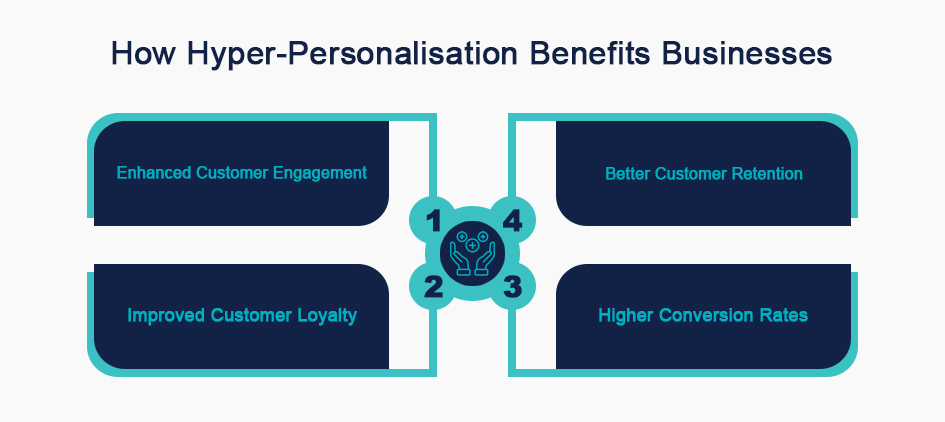
Why Hyper-Personalisation is a Game Changer?
 In today’s fast-paced, data-driven environment, businesses continuously seek innovative methods to connect with customers on a deeper, more meaningful level. Hyper-personalisation, driven by advanced data analytics, is one such approach that is revolutionising how companies engage with their audience. This strategy focuses on providing highly tailored experiences for each customer based on the wealth of data gathered from their online behaviours, preferences, and interactions.
In today’s fast-paced, data-driven environment, businesses continuously seek innovative methods to connect with customers on a deeper, more meaningful level. Hyper-personalisation, driven by advanced data analytics, is one such approach that is revolutionising how companies engage with their audience. This strategy focuses on providing highly tailored experiences for each customer based on the wealth of data gathered from their online behaviours, preferences, and interactions.
Through this article, we will explore how advanced data analytics is driving hyper-personalisation, why it matters for businesses, and how organisations can effectively implement it to improve customer experiences and boost growth.
What is Hyper-Personalisation?
 Hyper-personalisation refers to the process of using advanced analytics and real-time data to deliver unique, individualised customer experiences. It goes beyond simple personalisation by using a combination of customer behaviour data, artificial intelligence (AI), and machine learning (ML) to create experiences that are specifically tailored to each customer’s preferences, location, and past interactions.
Hyper-personalisation refers to the process of using advanced analytics and real-time data to deliver unique, individualised customer experiences. It goes beyond simple personalisation by using a combination of customer behaviour data, artificial intelligence (AI), and machine learning (ML) to create experiences that are specifically tailored to each customer’s preferences, location, and past interactions.
Traditional Personalisation vs. Hyper-Personalisation
 Traditional personalisation often relies on simple demographic information, such as age, gender, and location. While this approach can work to a degree, it doesn’t account for the more nuanced preferences of each customer. Hyper-personalisation, on the other hand, leverages complex data points, such as browsing habits, previous purchases, social media activity, and even real-time behaviours, to craft a dynamic, individualised experience.
Traditional personalisation often relies on simple demographic information, such as age, gender, and location. While this approach can work to a degree, it doesn’t account for the more nuanced preferences of each customer. Hyper-personalisation, on the other hand, leverages complex data points, such as browsing habits, previous purchases, social media activity, and even real-time behaviours, to craft a dynamic, individualised experience.
The Role of Advanced Data Analytics in Hyper-Personalisation
The Power of Big Data
At the heart of hyper-personalisation lies big data. Modern businesses have access to a vast amount of information, including user activity, purchase history, website interactions, and other relevant data. Advanced data analytics allows businesses to analyse this data to uncover hidden patterns and trends. By utilising predictive analytics, AI, and machine learning, Companies can gain a deeper insight into their potential customers and craft personalised experiences that are truly unique and relevant.
Data Sources that Drive Hyper-Personalisation
Several data sources fuel hyper-personalisation efforts, including:

How Hyper-Personalisation Benefits Businesses
Implementing Hyper-Personalisation with Advanced Data Analytics
 Collecting the Right Data
Collecting the Right Data
The first step toward effective hyper-personalisation is collecting the correct data. This involves tracking customer behaviour across multiple channels and touchpoints, including web browsing, app usage, email interactions, and social media engagement. Businesses should focus on collecting high-quality, actionable data rather than just accumulating large volumes of information.
 Utilising Artificial Intelligence and Machine Learning
Utilising Artificial Intelligence and Machine Learning
Artificial Intelligence (AI) and Machine Learning (ML) are essential for effectively analysing large-scale data. These technologies can predict customer behaviour, categorise audiences, and recommend products or services tailored to individual preferences. Implementing AI-powered tools helps businesses understand complex customer patterns and make data-driven decisions to personalise experiences.
 Personalising the Customer Journey
Personalising the Customer Journey
Hyper-personalisation is about crafting a unique journey for each customer. From the first point of contact through to post-purchase interactions, businesses should tailor every touchpoint to meet the needs of their customers. This includes personalised emails, website content, product recommendations, and even customer support services that are customised based on data insights.
 Real-Time Personalisation
Real-Time Personalisation
Real-time data is key to successful hyper-personalisation. By using data from ongoing customer interactions (e.g., website visits and social media activity), businesses can make dynamic adjustments to the customer experience. For example, if a customer is browsing a particular product category, they may receive a targeted offer or a personalised message immediately.

Challenges in Hyper-Personalisation
The Future of Hyper-Personalisation
 AI and Automation
AI and Automation
As AI and automation technologies continue to evolve, the future of hyper-personalisation will be even more advanced. Businesses will be able to deliver personalised experiences at scale, leveraging AI to automatically adjust content, recommendations, and offers based on real-time data.
 Omnichannel Personalisation
Omnichannel Personalisation
With the rise of omnichannel marketing, businesses will need to ensure that personalised experiences are delivered seamlessly across all platforms, including mobile apps, websites, social media, and in-store experiences. The integration of various data points from each channel will be essential in providing a cohesive, personalised customer journey.
 Predictive Personalisation
Predictive Personalisation
In the future, businesses will anticipate customer needs before they express them. Predictive analytics, fuelled by big data, will allow companies to offer personalised experiences based on future behaviour, such as recommending products before customers even begin browsing.
Companies like Datavision are leading the charge in digital transformation. Learn more about Datavision here.
Conclusion
Hyper-personalisation through advanced data analytics presents a tremendous opportunity for businesses to engage with their customers in more meaningful and impactful ways. By harnessing the power of big data, AI, and machine learning, companies can deliver unique, personalised experiences that drive customer satisfaction, loyalty, and ultimately, business growth. Despite existing challenges, the benefits of hyper-personalisation greatly exceed the obstacles. Businesses that effectively implement this strategy will emerge as leaders in their respective industries.
FAQs
How Can Datavision help?
We assist various financial institutions and global banks on their digital transformation journey. Our one-of-a-kind approach, which combines people, process, and technology, expedites the delivery of superior results to our clients and drives excellence. Several reputed companies leverage our proprietary suite of business excellence tools and services to unlock new growth levers and unparalleled ROI.
Datavision stands proudly as a prominent banking software solutions provider, recognized for our unwavering commitment to excellence in the industry. We have earned our esteemed reputation by consistently delivering cutting-edge core banking software, catering to the needs of both retail and corporate banking software sectors. At Datavision, our mission is clear: to provide our clients with the best banking software products, ensuring that they stay ahead in an ever-evolving financial landscape. We take pride in serving our prestigious clients and look forward to continuing our journey of innovation and excellence.
Our portfolio of banking software product and services include:
Core Banking Solutions: | FinNext Core | Banking: | FinTrade | EasyLoan | MicroFin |
Digital Banking Solutions: | IBanc | MobiBanc | MBranch | FinTab | FinSight |
Risk & Compliance: |FinTrust |
Want to know how our team of experts at Datavision provides customizable, scalable, and cost-effective banking software products and solutions to our esteemed clients? Visit us for more information.